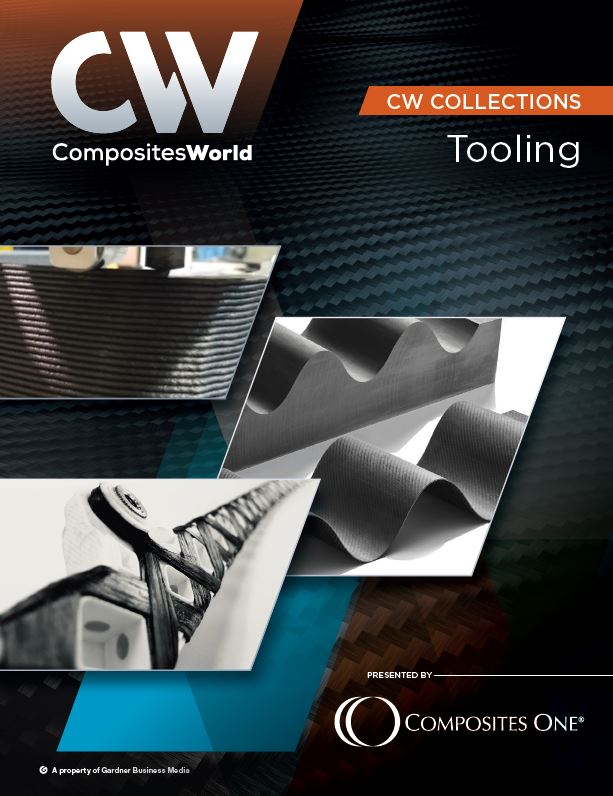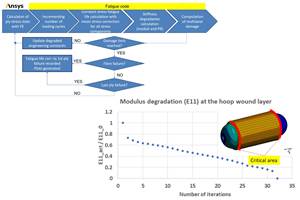Environmental testing of composites
Additional testing of polymer matrix composites (PMCs) is often performed in alternate environmental conditions to determine properties related to temperature and moisture sensitivity.
Although mechanical testing of polymer matrix composites (PMCs) is most commonly performed in ambient laboratory conditions, additional testing is often performed in other environmental conditions to determine properties of interest. Additional test environments typically include higher or lower test temperatures as well as elevated levels of absorbed moisture in the test specimens. The selection of these environmental conditions for testing is based on established limits of the composite material’s usage as well as the environmental conditions expected in service.
In general, the mechanical properties of PMCs can be affected significantly by exposure to elevated temperature. However, the combination of elevated temperature and absorbed moisture, referred to as hot/wet conditions, often produce the most critical environmental conditions for which the most severe reductions are produced in several important mechanical properties.
Welcome! You’ve unlocked premium content.
The determination of appropriate environmental conditions for elevated temperature testing of PMCs starts with the determination of the material’s glass transition temperature, Tg. As explained in my October 2018 column, the Tg of a polymer is the temperature corresponding with a two to three order of magnitude reduction in its stiffness. Additionally, since hot/wet conditions are of even greater concern, wet Tg testing is performed using moisture-conditioned test specimens, often resulting in a significantly reduced temperature. The material operational limit (MOL) is often established based on the wet Tg temperature. As a general guide for material selection purposes, the MOL typically is selected to be 28°C/50°F below the wet Tg temperature1. However, smaller temperature reductions below the wet Tg temperature may be acceptable when supported by sufficient elevated temperature testing covering the full range of expected high-temperature environments expected for a particular application.
As expected, the “matrix-dominated” mechanical properties of PMCs, such as stiffness and strength under shear and transverse (90°) tension loading, are most affected by hot/wet environmental conditions. While polymeric fibers such as aramid are also significantly affected by these conditions, carbon and glass reinforcing fibers are not. Therefore the “fiber-dominated” mechanical properties of carbon and glass fiber composites, such as the longitudinal (0°) tension stiffness and strength, are relatively unaffected by these environmental conditions. Interestingly, the longitudinal (0°) compression strength, often thought of as a fiber-dominated property, exhibits a significant decrease at hot/wet testing conditions. The reason? The fiber-direction compression strength depends on the matrix material to support the fibers and resist fiber microbuckling failure. Additionally, hot/wet testing conditions can produce an increase in some mechanical properties due to the matrix material becoming plasticized and exhibiting higher toughness. As an example, the open-hole tensile strength (ASTM D57662), a measure of the notch sensitivity of a PMC, may increase under hot/wet conditions since the formation of matrix damage is inhibited by this toughness increase.
At ambient temperature, a PMC can take months or years to reach this “wet” condition, defined as a state of moisture equilibrium throughout its thickness. Since moisture diffusion rates increase significantly with temperature, composite test specimens may be moisture conditioned in shorter times at elevated temperatures. However, there are limits on the moisture-conditioning temperature, as excessive conditioning temperatures can produce property changes in the polymer matrix that are not representative of moisture conditioning at ambient humid conditions. For example, the Composite Materials Handbook (CMH-17) suggests a maximum conditioning temperature of 82°C/180°F for epoxy-based composites cured at 177°C/350°F. For lower-temperature-cure epoxies, lower conditioning temperatures are suggested3. As described in ASTM D52294, there is no specified time period for moisture conditioning, as moisture equilibrium is established by the mass of the specimen changing by less than 0.02 percent between successive measurements. Further, the use of pressurized steam or water immersion are discouraged, as they do not produce the same state of moisture saturation as would occur at ambient temperatures with humid air and do not produce significant reductions in conditioning time.
Although testing under hot/wet conditions often is the most critical environmental condition for PMCs, mechanical testing is also commonly performed at sub-ambient temperatures. Since no lower-temperature MOL exists analogous to that based on the wet Tg for elevated temperatures, testing is often performed at the lower-limit temperature established for a particular application. Within the aerospace industry, for example, a lower-limit temperature of -54°C/-65°F is used for many applications. At this sub-ambient temperature, mechanical testing is typically performed with specimens in either an ambient or dry moisture condition, the latter defined as being in moisture equilibrium with an environment at 5 percent or less relative humidity3. The reason? The absence of absorbed moisture coupled with a cold test temperature produces a more brittle material behavior in the polymer matrix, resulting in reduced toughness and greater susceptibility to matrix damage. As a result, some fiber-dominated mechanical properties, such as the open-hole tensile strength (ASTM D57662), may exhibit reduced values under cold testing conditions. If a dry test condition is desired, specimens are placed in a drying oven at temperatures similar to those used for moisture conditioning.
Finally, in addition to testing in alternate environmental conditions, mechanical testing also may be performed to evaluate the sensitivity of PMCs to other fluids to which they may be exposed to in a particular application. Such fluids may include fuels, lubricants, deicing fluids and cleaners used in service. To assess the fluid sensitivity of a PMC, test methods that are sensitive to changes in matrix-dominated properties are commonly used. The ±45° tensile shear test, ASTM D35185, is commonly used for this purpose. This test is relatively simple to perform and produces a matrix-sensitive nonlinear shear-stress-versus-shear-strain curve that allows for thorough comparative assessments.
The open-hole compression test, ASTM D64846, is typically performed using a quasi-isotropic laminate and is an important design value for many applications. The test shows sensitivity to matrix degradation, thus is useful for fluid sensitivity assessments. The short beam shear test, ASTM D23447, is the simplest and most affordable option for assessing fluid sensitivity. For all of these possible tests, results obtained from specimens subjected to fluid exposure are compared to unexposed control specimens tested at both ambient and hot/wet conditions to assess the severity of exposure to a particular fluid. The Composite Materials Handbook (CMH-17)3 provides further details of fluid sensitivity testing methods with a focus on aerospace applications.
References
1Composite Materials Handbook - 17 (CMH-17), Volume 1, Section 6.6.3: “Glass Transition Temperature,” SAE International, Rev. G, 2012.
2ASTM D5766/D5766M-11 (2018), “Standard Test Method for Open-Hole Tensile Strength of Polymer Matrix Composite Laminates," ASTM International (W. Conshohocken, PA, US), 2018.
3Composite Materials Handbook - 17 (CMH-17), Volume 1, Section 6.3: “Conditioning and Environmental Exposure,” SAE International, Rev. G, 2012.
4ASTM D5229/D5229M-14 (2014), “Standard Test Method for Moisture Absorption Properties and Equilibrium Conditioning of Polymer Matrix Composite Materials," ASTM International (W. Conshohocken, PA, US), 2014.
5ASTM D3518/D3518M-18 (2018), “Standard Test Method for In-Plane Shear Response of Polymer Matrix Composite Materials by Tensile Test of a ±45° Laminate," ASTM International (W. Conshohocken, PA, US), 2018.
6ASTM D6484/D6484M-14 (2014), “Standard Test Method for Open-Hole Compressive Strength of Polymer Matrix Composite Laminates," ASTM International (W. Conshohocken, PA, US), 2014.
7ASTM D2344/D2344M-16 (2016), “Standard Test Method for Short-Beam Strength of Polymer Matrix Composite Materials and Their Laminates," ASTM International (W. Conshohocken, PA, US), 2016.
Related Content
Notched testing of sandwich composites: The sandwich open-hole flexure test
A second new test method has been standardized by ASTM for determining notch sensitivity of sandwich composites.
Read MoreTesting to support composite bolted joint analysis
An overview of ASTM Standard Guide D8509, and its coupon-level mechanical testing of design properties for analyzing composite bolted joints.
Read MoreNumerical tool with mean stress correction demonstrated for fatigue life estimation of thermoplastic composites
To aid design of fatigue-resistant structures, Econ Engineering has developed an algorithm to evaluate ply-based cyclic stiffness degradation combined with an FE failure check, validated for a CF/PAEK pressure vessel.
Read MorePhotothermal tomography for locating, quantifying defects in composites
Years of infrared testing development result in thermography technology that is no longer just qualitative, but can define defect size and depth, making additional UT scans obsolete.
Read MoreRead Next
VIDEO: High-volume processing for fiberglass components
Cannon Ergos, a company specializing in high-ton presses and equipment for composites fabrication and plastics processing, displayed automotive and industrial components at CAMX 2024.
Read More“Structured air” TPS safeguards composite structures
Powered by an 85% air/15% pure polyimide aerogel, Blueshift’s novel material system protects structures during transient thermal events from -200°C to beyond 2400°C for rockets, battery boxes and more.
Read More

















